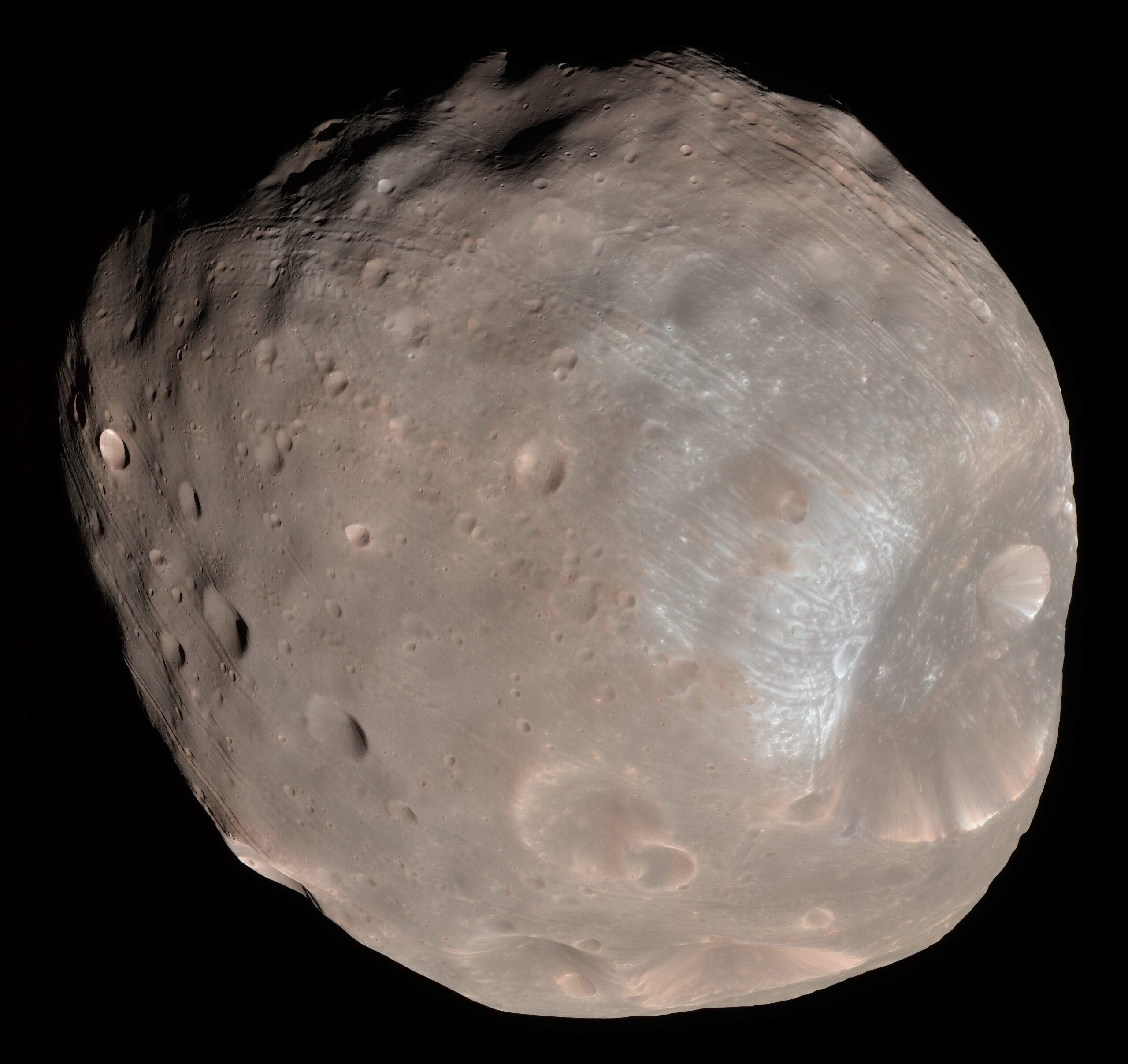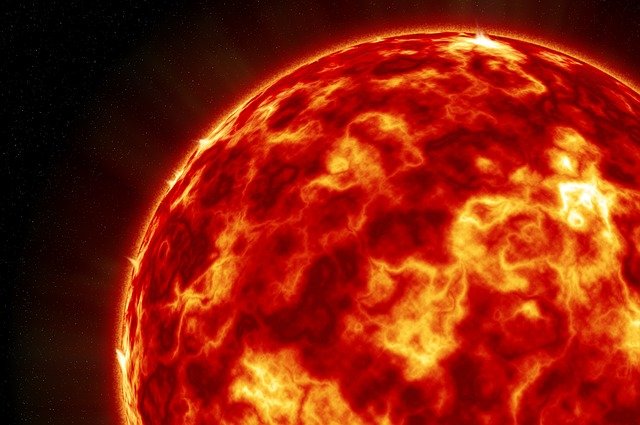*This post may contain affiliate links. This means we may make a commission if you purchase an item using one of our links*
The main differences between the Sun and Phobos is that the Sun is the central entity in our solar system that all objects in its local region orbit, has a diameter of 1.39 million km and is the brightest entity in our solar system that produces energy for life to exist via nuclear fusion whilst Phobos is far smaller with diameter of 22.53km and is one of two moons that orbit Mars.
There are numerous other differences between the Sun and Phobos so, continue reading for a more in-depth look at each celestial object along with their similarities and differences below.
What Is The Moon Phobos?
Table of Contents

Phobos is the larger and innermost of the Martian moons, named after the Greek God of fear and panic. This rocky satellite measures approximately 27 x 22 x 18 kilometers and possesses an irregular shape.
Flying only 270 km above Mars’s surface, Phobos orbits the Martian surface so closely that it spins around the planet three times a day (each orbit takes 7 hours and 39 minutes). And this proximity means that the moon cannot always be seen from Mars’ surface (it all depends on where you’re standing).
In general, Phobos rises in the west, passes through the sky in around 4 hours, and sets in the east. And this process occurs twice during one Martian day.
Phobos travels 1.8 m closer to Mars every 100 years, which means this doomed moon will one day crash into its planet or break up into rings. Still, this won’t happen for another 50 million years or so.
The moon is covered in streak patterns from impact craters, the most significant of which is the crater Stickney, with a diameter of 9.7 km. Phobos has weathered thousands of meteorite impacts, one of which almost shattered it to pieces.
It was first discovered by the American astronomer Asaph Hall on 17th August 1877. But, it can be difficult for astronomers to see as it is one of the least reflective bodies in the solar system with an albedo of 0.071.
Despite its small stature, Phobos experiences wildly varying temperatures on its dark side compared to the light side. Measurements on the light side of the moon suggest that temperatures can rise to -4 degrees Celsius, a sort of brisk winter’s day that would be cold but tolerable.
In contrast, temperatures on the dark side can drop to -112 degrees Celsius, even though the two areas are just a few kilometers apart. The probable cause is fine surface dust that cannot retain heat, allowing temperatures to drop rapidly.
The low density of Phobos suggests its composition is similar to carbonaceous chondrite meteorites, which could mean that Phobos is a captured asteroid.
What Is The Sun?

The moon is the gray celestial being that orbits our Earth. It is also tidally locked to Earth meaning that we only see one side of it at any time in our sky.
It takes the moon roughly 27 days to complete an orbit around Earth, which it does in an elliptical pattern. The Moon’s axial tilt is very straight at 1.5 degrees. As a result of the tidally locked status along with the effects that Earth has on its general rotational patterns, it takes the Moon roughly 29.5 days to complete a day.
In regards to its temperature, it fluctuates where it can be really hot at 127 degrees Celsius when the Sun is shining on it and to -173 degrees in areas where the Sun does not strike it. It’s core on the other hand is far hotter ranging between 1,327 to 1,427 degrees Celsius.
This is as a result of the lunar entity’s extremely thin to practically non-existent atmosphere, which not only results in these massive temperature shifts but, is also the reason why it has over 100,000 craters on its surface.
Speaking of the Moon’s surface, the entity is mostly made of rocks, iron, magnesium just like most of the other moons and terrestrial based planets in our solar system.
It is among the bigger moons in our solar system with a diameter of 3,474.8km and a mass of 7.35 × 10^22 kg, which actually places it fifth amongst all moons in our solar system and would also make it bigger than the dwarf planet Pluto.
Despite all the advancements in technology, the last time a manned mission was made to the Moon was on the Apollo 17 way back in December 1972 and no further missions have been done since, possibly as result of the political agendas behind the numerous countries vying for opportunities that we don’t know of.
The Similarities Between Phobos And The Sun
Although the Sun and Phobos don’t have too many similarities, there still are a few features they do share, which in this case includes the following:
- Both have a hotter central core.
- Both are part of the same solar system.
The Differences Between Phobos And The Sun
As for the differences between the two, they include the below:
- Phobos is far smaller than the Sun with a diameter of 22.53km whilst the Sun has a diameter of 1.39 million km.
- The Sun has more mass than Phobos too where it is 1.989 × 10^30 kg or 1 solar mass whilst Phobos’ is 10.6 × 10^15 kg.
- The Sun has a strong magnetic field while Phobos has no magnetic field.
- Phobos is a terrestrial entity whilst the Sun is mostly gas based.
- The Sun is the hottest entity in our solar system where it has a temperature of 6,000 degrees Celsius whilst Phobos’ temperature fluctuates between 127 degrees Celsius and -173 degrees Celsius.
- In regards to the core temperature, the Sun’s is 15 million degrees whilst Phobos has no core.
- Phobos orbits Mars in an elliptical pattern whilst the Sun does not orbit any other object.
- Phobos is tidally locked to Mars whilst the Sun is not tidally locked to anything.
- Phobos has no objects orbiting it whilst the Sun has the whole solar system orbiting it.
- The Sun goes through nuclear fusion whilst Phobos does not.
- When the Sun dies it will become a white dwarf whereas Phobos will not become a different celestial when it breaks apart.
- Phobos only orbits Mars 6,000km away and is getting closer to the planet by 1.8 meters every 100 years.
- Phobos is not spherical while the Sun is a spherical shape.
Summary
The Sun and Phobos are completely different entities. One is a giant ball of fire and energy found in the center of the solar system whilst the other is a rocky natural satellite that orbits Mars.
The differences in size, temperature, effect on other entities and even composition show dissimilar they are to each other and is the reason why they fall under completely different brackets for celestial objects within the cosmos.


